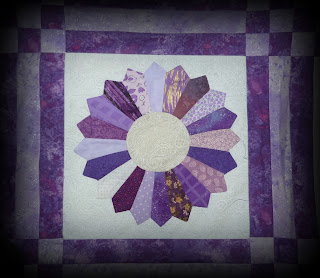People often ask me if I belong to a guild or quilting group. Sometimes they look at me funny when I tell them, no, I’m a lone quilter.
While I’m not averse to the social aspects of quilting in a crowd, lone quilting is more than an activity to me; it is a philosophy. I think of quilting as a form of meditation. It is an activity that allows for deep personal thought. It is therapy. I find I am very busy these days and juggle lots of responsibility. There is seldom enough time in the day to accomplish all that needs to be done, so often times, I don’t even try. I am not the kind of person that frets over a sink full of dirty dishes. I figure they will wait for me. I always get around to the chores that need doing, but I get around to them on my time.
Quilting is one activity I want to make time for. It is a kind of precious gift I give to myself, not unlike baking myself a birthday cake. I relish the alone time, feeling free, as my mind wanders wherever it wants to go.
I am a self-taught quilter who enjoys learning new things, especially something creative that inspires me. And though I’ve been quilting for nearly 20 years, I still consider myself a newbie. There is so much to learn, to try, and to practice. This type of learning requires deep concentration, where all my faculties can engage with little distraction.
But just because I don’t physically go elsewhere to work on a quilt, that doesn’t mean I don’t belong to quilting groups. In fact, I do belong to several on the computer. Modern quilting allows the best of both worlds--lone quilting and social interaction. Internet quilting groups are great for advice, counsel, and camaraderie. Online sources also offer nearly endless learning potential.
Ironically, one of the most inspirational aspects of quilting for me, is its rich history. The quilting bee was a huge part of the history of quilting; its root remains relevant today in various guilds and church groups. I have always been drawn to stories about brave American pioneer families who traveled west to seek a better life. Quiltmaking was a huge part of the American story in the late 18th and early 19th centuries. Quilting was a social activity for women of the day, but moreso, handmade quilts were a necessity for survival during long, cold winter months. Women’s use of fabric from worn out clothing and livestock feed sacks was necessary for their survival.
Socialization with other women, as well as the need to finish sewing together the pieces of cloth that would warm their families, was probably as psychologically necessary to pioneer women as lone quilting is to me today.
Quiltmaking has gone through such evolution. No longer strictly functional, the modern quilt story is much more complex. Traditional function remains one of its amenities, but quilts today represent everything from a way to earn a living to the creation of fine art. Quilts come in various sizes, from huge bed quilts to table runners, wall hangings, and candle pads. They use design and color in new ways as well. Modern quilts range from the traditional log cabin, bear paw, and churn dash quilt blocks to the complex computer-drawn star points. There are also new uses of a variety of fabric and thread. The creations are limited only by their creator's imagination and skill.
There is no end to the inspiration, which is largely what intrigues me the most. I want to make a rag quilt, a one-block wonder, bargello, art quilts, and so much more. I want to improve my paper-piecing techniques, and learn new free-motion quilting designs, as well as hone my skills on those I’ve already done. I want to return to hand-quilting, and further experiment with color.
I finished my first quilt in 2003. I have made many more since. I knew then that I loved quiltmaking and I would be a quilter for the rest of my life. My quilting journey has shown me there is no end to this creative process. Every new idea brings about an endless stream of new ideas, limited only by our own imagination.
While I will likely never go to a quilting group, I do belong to several virtual groups. The computer is another tool that has enhanced the quilting experience. I have learned so much because of the ability to watch other quilters on videos. I owe each of them a debt.
 The hardest part about this quilt so far, is picking out the colors. There are a lot of them. I could have just purchased the kit, but isn’t that why I buy fabrics? It took a little while, but I think I have this all sorted out finally.
The hardest part about this quilt so far, is picking out the colors. There are a lot of them. I could have just purchased the kit, but isn’t that why I buy fabrics? It took a little while, but I think I have this all sorted out finally. 





 I tried spray basting a quilt for the first time. Whoa, there has to be a better way. Or, I’m just not doing it right.
I tried spray basting a quilt for the first time. Whoa, there has to be a better way. Or, I’m just not doing it right.

